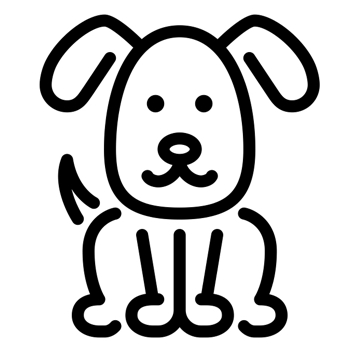Golden Mountain Dog

Big and beautiful are two words that personify the Golden Mountain Dog – a crossbreed of the Golden Retriever and the Bernese Mountain Dog. Not only are they incredibly handsome and noble looking dogs, but they are also beautiful on the inside! Caring and loving, the Golden Mountain Dog will always put its family first and is incredibly affectionate.
With a soft and thick coat that is often brown and black, the Golden Mountain Dog looks a lot like a Golden Retriever that has been coloured in! With a sturdy and athletic body, this is a powerful dog that does require a good deal of exercise to keep it in shape.
About & History
While the Golden Mountain Dog may sound more like a mythical creature than a designer dog breed, this mix between the sweet-natured Golden Retriever and the dedicated Bernese Mountain Dog is now a reality. Little is known about when and where they were first bred, but we have plenty of information about their parents.
The Golden Retriever
The Golden Retriever is an incredibly popular breed of dog that was established during the 1800s within Scotland. They were developed in order to create a dog that could adequately retrieve prey from both land and water. Breeds, such as the Flat Coated Retriever and Irish Setter, form part of their bloodline.
As well as continuing to be used as a hunting companion, the Golden Retriever is often seen working as a guide dog and therapy dog, thanks to their heart of gold and high levels of tolerance and patience.
The Bernese Mountain Dog
The Bernese Mountain Dog is a working dog from Switzerland who has been working as a farm dog for centuries; herding livestock and guarding them from potential predators. While they require a lot of exercise and attention, they are frequently kept as family pets on mainland Europe.
Appearance
The Golden Mountain Dog is an impressively big dog with a robust body that is built in proportion and should not have any exaggerated features. Their head tends to be slimmer than that of the Bernese Mountain Dog and more closely resembles that of the Golden Retriever. Their muzzle is medium in length and ends in a good-sized, black nose. Their deep brown eyes are relatively small and portray an alert expression. As with their parents, their ears hang down to frame their face and are not overly long or heavy. Their limbs are straight and powerful, ending in wide paws.
The coat of the Golden Mountain Dog is medium in length and incredibly dense and fluffy. Though called the ‘Golden’ Mountain Dog, their fur is actually not golden in colour and most individuals are black, bi-colour (black and white or black and brown) or tri-colour (black, white and brown). When mature, these large dogs can reach heights of 61cm to 66cm and weights of 34kg to 50kg.
Character & Temperament
Often described as a ‘gentle giant’, the Golden Mountain Dog is a kind-hearted and affable soul that is as easy-going as they come. They show a great deal of loyalty towards their family and become particularly attached to the children of the household, who they will aim to protect and keep safe. While sensible, these dogs also have a playful streak and love to joke about and play games.
Calm and quiet most of the time, the Golden Mountain Dog makes a pleasant companion and a well-mannered house guest. While they may bark at new arrivals, they do not make good guard dogs, as they tend to welcome strangers willingly.
Though the Golden Mountain Dog is people-orientated and loves to be around animals of the two-legged variety, they do not tend to become over-reliant on them and conditions, such as separation anxiety rarely develop. An independent animal, the Golden Mountain Dog is quite content in its own company or in the company of other dogs.
Trainability
A clever dog that learns quickly and loves to please their master, the Golden Mountain Dog is fun to train and the whole family can get involved. Training can begin as soon as they arrive home, starting with basic commands, such as ‘sit’ and ‘paw’. Most will master these quickly and then can move on to more complex commands and even activities, such as agility and scent trailing.
A breed that can excel in a variety of disciplines, the Golden Mountain Dog can be trained to carry out a number of roles, such as that of a service dog or search and rescue dog. Their intelligence and good disposition make them wonderful ‘employees’.
Health
While crossbreeds usually enjoy better health than purebreds, the Golden Mountain Dog is prone to a number of health conditions that can impair their quality of life and reduce their lifespan, which is typically from eight to ten years. Watch out for the following:
Hypothyroidism
Often the symptoms for an underactive thyroid are confused by owners as ‘normal ageing’, as they can be subtle and insidious. Dogs may be slowly gaining weight and suffering with poor fur quality and symmetrical patches of baldness.
They may also be less willing to exercise and be more sluggish than usual. Blood tests can help to diagnose the condition and medication will be prescribed to treat it. Though there is no cure, affected dogs respond very well to daily medicine.
Cancer
Certain cancers, such as haemangiosarcoma, histiocytoma and osteosarcoma, are seen more often in the Golden Mountain Dog than in other breeds. As with any cancer, the sooner it is diagnosed, the better the prognosis, so owners should be vigilant and be on the watch for any new growths or unusual symptoms, such as a limp that won’t go away.
Hip Dysplasia
In the last few decades, there has been a real move towards responsible breeding that puts the animals’ health above everything else. Hip scoring is an example of a screening test that should be undertaken on all Golden Mountain Dogs that are to be used for breeding as any animal with a high hip score should not be used to reproduce and should be neutered. Dogs with hip dysplasia tend to suffer with poor mobility and chronic pain that worsens throughout their lifetime.
Bloat
A scary condition that can come on in a matter of minutes, bloat is most often seen in dogs with very deep chests. Though it has been suggested that bloat can be linked to eating dry kibble, bolting food quickly and exercising straight after eating, experts are unsure as to why some dogs develop it and others do not.
A dog that has a bloated abdomen and is restless and agitated needs to be assessed by a vet urgently in case of bloat. Affected dogs will have their stomach decompressed and will be stabilised before they are put through the surgery to replace their stomach in the correct position, which should be curative.
Obesity
Both the Golden Retriever and the Bernese Mountain Dog can be ‘easy keepers’, i.e. they will put on weight easily if either over-fed or under-exercised. As obesity can reduce an animal’s lifespan and decrease their quality of life, it is something that needs to be avoided at all costs. Most veterinary clinics will offer weight clinics, which overweight dogs can attend in an effort to get them to reach their ideal weight.
Exercise and Activity Levels
As the Golden Mountain Dog is such a large breed it is essential to not over-exercise them when they are developing. To do so can put stress on their bones and joints and lead to orthopaedic issues as they mature. Once fully-grown, they require a good deal of exercise and are always happy to tag along on a scenic hike or long jog.
As the Golden Mountain Dog comes from working stock, they will not be content to laze about indoors all day and need to be both physically and mentally stimulated to prevent boredom and obesity. The more varied their day-to-day activities the better as they enjoy learning new tasks and doing different things.
Caution is advised during hot and humid weather as the dense coat of these dogs makes them prone to over-heating. Swimming is a good activity during warm weather and dogs should be taken out when the sun is down to keep them cool.
Grooming
The thick, luxurious coat of the Golden Mountain Dog needs to be brushed at least once a day – a task which is best carried out outside to reduce shedding within the home. Dogs should get into the routine of being brushed down and having their teeth brushed and ears checked each day. Claw clipping is also something that should be introduced from a young age and will usually need to be done every six to eight weeks or so.

